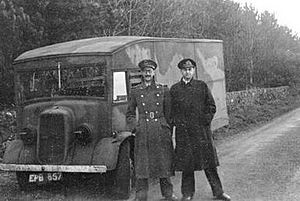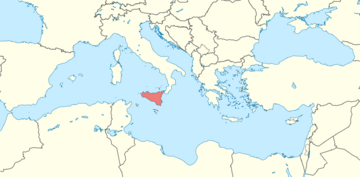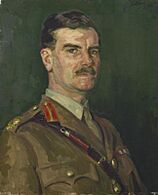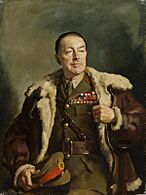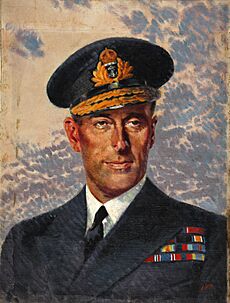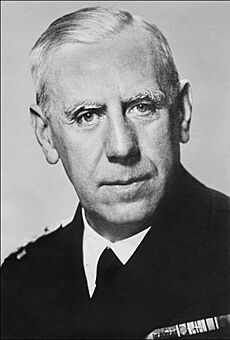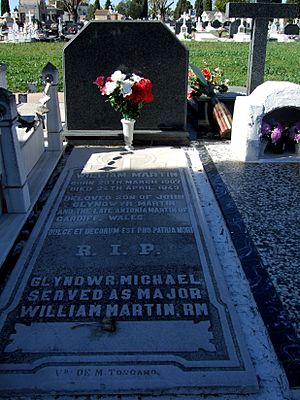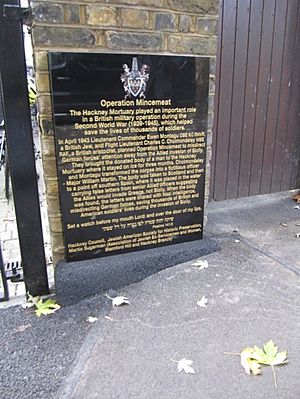Operation Mincemeat facts for kids
Quick facts for kids Operation Mincemeat |
|
|---|---|
| Part of Operation Barclay | |
| Operational scope | Tactical deception |
| Location | Spain |
| Planned | 1943 |
| Planned by | |
| Target | Abwehr |
| Date | April 1943 |
| Executed by | |
| Outcome | Successful |
Operation Mincemeat was a successful British deception operation of the Second World War to disguise the 1943 Allied invasion of Sicily. Two members of British intelligence obtained the body of Glyndwr Michael, a tramp, dressed him as an officer of the Royal Marines and placed personal items on him identifying him as the fictitious Captain (Acting Major) William Martin. Correspondence between two British generals that suggested that the Allies planned to invade Greece and Sardinia, with Sicily as merely the target of a feint, was also placed on the body.
Part of the wider Operation Barclay, Mincemeat was based on the 1939 Trout memo, written by Rear Admiral John Godfrey, the Director of the Naval Intelligence Division, and his personal assistant, Lieutenant Commander Ian Fleming. With the approval of the British Prime Minister, Winston Churchill, and the military commander in the Mediterranean, General Dwight D. Eisenhower, the plan began by transporting the body to the southern coast of Spain by submarine and releasing it close to shore, where it was picked up the following morning by a Spanish fisherman. The nominally neutral Spanish government shared copies of the documents with the Abwehr, the German military intelligence organisation, before returning the originals to the British. Forensic examination showed they had been read and Ultra decrypts of German messages showed that the Germans fell for the ruse. German reinforcements were shifted to Greece and Sardinia before and during the invasion of Sicily; Sicily received none.
The full effect of Operation Mincemeat is not known, but Sicily was liberated more quickly than anticipated and losses were lower than predicted. The events were depicted in Operation Heartbreak, a 1950 novel by the former cabinet minister Duff Cooper, before one of the intelligence officers who planned and carried out Mincemeat, Ewen Montagu, wrote a history in 1953. Montagu's work formed the basis for the 1956 British film The Man Who Never Was. A second British film based on the events was released in 2021 under the title Operation Mincemeat.
Background
Inspiration for Mincemeat
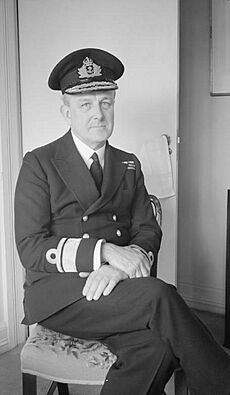
On 29 September 1939, soon after the start of the Second World War, Rear Admiral John Godfrey, the Director of Naval Intelligence, circulated the Trout memo, a paper that compared the deception of an enemy in wartime to fly fishing. The historian Ben Macintyre observes that although the paper was published under Godfrey's name, it "bore all the hallmarks of ... Lieutenant Commander Ian Fleming", Godfrey's personal assistant. The memo contained a number of schemes to be considered for use against the Axis powers to lure U-boats and German surface ships towards minefields. Number 28 on the list was titled: "A Suggestion (not a very nice one)"; it was an idea to plant misleading papers on a corpse that would be found by the enemy.
The deliberate planting of fake documents to be found by the enemy was not new; known as the Haversack Ruse, it had been practised by the British and others in the First and Second World Wars. In August 1942, before the Battle of Alam el Halfa, a body was placed in a blown-up scout car, in a minefield facing the German 90th Light Division. On the body was a map purportedly showing the locations of British minefields; the Germans used the map, and their tanks were routed to areas of soft sand where they bogged down.
In September 1942 an aircraft flying from Britain to Gibraltar crashed off Cádiz. All aboard were killed, including Paymaster-Lieutenant James Hadden Turner – a courier carrying top secret documents – and a French agent. Turner's documents included a letter from General Mark Clark, the American Deputy Commander of the Allied Expeditionary Force, to General Noel Mason-MacFarlane, British Governor and Commander in Chief of Gibraltar, informing him that General Dwight D. Eisenhower, the Supreme Commander, would arrive in Gibraltar on the eve of Operation Torch's "target date" of 4 November. Turner's body washed up on the beach near Tarifa and was recovered by the Spanish authorities. When the body was returned to the British, the letter was still on it, and technicians determined that the letter had not been opened. Other Allied intelligence sources established that the notebook carried by the French agent had been copied by the Germans, but they dismissed it as being disinformation. To British planners, it showed that some material that was obtained by the Spanish was being passed to the Germans.
British Intelligence and the inspiration for the plan
A month after the Turner crash, the British intelligence officer Charles Cholmondeley outlined his own variation of the Trout memo plan, codenamed Trojan Horse, after the Achaean deception from the Trojan War. His plan was:
A body is obtained from one of the London hospitals ... The lungs are filled with water and documents are disposed in an inside pocket. The body is then dropped by a Coastal Command aircraft ... On being found, the supposition in the enemy's mind may well be that one of our aircraft has either been shot or forced down and that this is one of their passengers.
Cholmondeley was a flight lieutenant in the Royal Air Force (RAF) who had been seconded to MI5, Britain's domestic counter-intelligence and security service. He had been appointed as the secretary of the Twenty Committee, a small inter-service, inter-departmental intelligence team in charge of double agents. In November 1942 the Twenty Committee turned down Cholmondeley's plan as being unworkable, but thought there may have been some potential in the idea. As there was a naval connection to the plan, John Masterman, the chairman of the committee, assigned Ewen Montagu, the naval representative, to work with Cholmondeley to develop the plan further. Montagu – a peacetime lawyer and King's Counsel who had volunteered at the outbreak of the war – worked under Godfrey at the Naval Intelligence Division, where he ran NID 17(M), the sub-branch which handled counter-espionage work. Godfrey had also appointed Montagu to oversee all naval deception involving double agents. As part of his duties, Montagu had been briefed on the need for deception operations to aid the Allied war aims in a forthcoming invasion operation in the Mediterranean.
Military situation
In late 1942, with the Allied success in the North African campaign, military planners turned their attention to the next target. British planners considered that an invasion of France from Britain could not take place until 1944 and the Prime Minister, Winston Churchill, wanted to use the Allied forces from North Africa to attack Europe's "soft underbelly". There were two possible targets for the Allies to attack. The first option was Sicily; control of the island would open the Mediterranean Sea to Allied shipping and allow the invasion of continental Europe through Italy. The second option was to go into Greece and the Balkans, to trap the German forces between the British and American invaders and the Soviets. At the Casablanca Conference in January 1943, Allied planners agreed on the selection of Sicily – codenamed Operation Husky – and decided to undertake the invasion no later than July. There was concern among the Allied planners that Sicily was an obvious choice – Churchill is reputed to have said "Everyone but a bloody fool would know that it's Sicily" – and that the build-up of resources for the invasion would be detected.
Adolf Hitler was concerned about a Balkan invasion, as the area had been the source of raw materials for the German war industry, including copper, bauxite, chrome and oil. The Allies knew of Hitler's fears, and they launched Operation Barclay, a deception operation to play upon his concerns and to mislead the Germans into thinking the Balkans were the objective, diverting resources from Sicily. The deception reinforced German strategic thinking about the likely British target. To suggest the eastern Mediterranean was the target, the Allies set up a headquarters in Cairo, Egypt, for a fictional formation, the Twelfth Army, consisting of twelve divisions. Military manoeuvres were conducted in Syria, with numbers inflated by dummy tanks and armoured vehicles to deceive observers. Greek interpreters were recruited and the Allies stockpiled Greek maps and currency. False communications about troop movements were generated from the Twelfth Army headquarters, while the Allied command post in Tunis – which was to be the headquarters of the Sicily invasion – reduced radio traffic by using landlines wherever possible.
Development
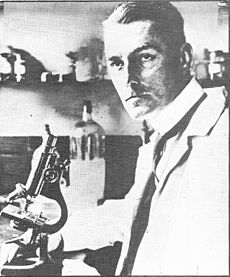
Developing the plan
Montagu selected the code name Mincemeat from a list of centrally held available possibilities. On 4 February 1943 Montagu and Cholmondeley filed their plan for the operation with the Twenty Committee; it was a re-working of Cholmondeley's Trojan Horse plan. The Mincemeat plan was to place documents on a body, and then float it off the coast of Spain, whose nominally neutral government was known to co-operate with the Abwehr, the German military intelligence organisation. The plan was passed by the committee, who passed it up the chain of command to the senior Allied strategists; Montagu and Cholmondeley were ordered to continue with their preparations for the operation.
Montagu and Cholmondeley began to create a "legend" – a fictitious background and character – for the body. The name and rank chosen was Captain (Acting Major) William Martin, of the Royal Marines assigned to Combined Operations Headquarters. The name "Martin" was selected because there were several men with that name of about that rank in the Royal Marines. As a Royal Marine, Major Martin came under Admiralty authority, and it would be easy to ensure that all official inquiries and messages about his death would be routed to the Naval Intelligence Division. Additionally, Royal Marines would wear battledress, which was easily obtainable and came in standard sizes. The rank of acting major made him senior enough to be entrusted with sensitive documents, but not so prominent that anyone would expect to know him.
To reinforce the impression of Martin being a real person, Montagu and Cholmondeley provided corroborative details to be carried on his person – known in espionage circles as wallet or pocket litter. These included a photograph of an invented fiancée named Pam; the image was of an MI5 clerk, Jean Leslie. Two love letters from Pam were included in the pocket litter, as was a receipt for a diamond engagement ring costing £53 10s 6d from a Bond Street jewellery shop. Additional personal correspondence was included, consisting of a letter from the fictitious Martin's father – described by Macintyre as "pompous and pedantic as only an Edwardian father could be" – which included a note from the family solicitor, and a message from Lloyds Bank, demanding payment of an overdraft of £79 19s 2d. To ensure that the letters would remain legible after immersion in seawater, Montagu asked MI5 scientists to conduct tests on different inks to see which would last longest in the water, and they provided him with a suitable list of popular and available ink brands.
Other items of pocket litter placed on Martin included a book of stamps, a silver cross and a St. Christopher's medallion, cigarettes, matches, a pencil stub, keys and a receipt from Gieves for a new shirt. To provide a date that Martin had been in London, ticket stubs from a London theatre and a bill for four nights' lodging at the Naval and Military Club were added. Along with the other items placed on him, an itinerary of his activity in London could be constructed from 18 to 24 April.
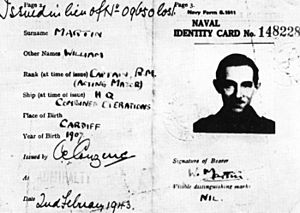
Montagu and Cholmondeley conducted a search for people who resembled the body, finding Captain Ronnie Reed of MI5; Reed agreed to be photographed for the identity card, wearing a Royal Marine uniform. As the three cards and passes needed to look not too new for a long-serving officer, they were issued as recent replacements for lost originals. Montagu spent the next few weeks rubbing all three cards on his trousers to provide a used sheen to them. To provide a used look to the uniform, it was worn by Cholmondeley, who was about the same build. The only non-issue part to the uniform was the underwear, which was in short supply in war-rationed Britain, so a pair of good-quality woollen underwear, owned by the late Herbert Fisher, the Warden of New College, Oxford, was used.
Deception documents
Montagu outlined three criteria for the document that contained the details of the falsified plans to land in the Balkans. He said that the target should be casually but clearly identified, that it should name Sicily and another location as cover, and that it should be in an unofficial correspondence that would not normally be sent by diplomatic courier, or encoded signal.
The main document was a personal letter from Lieutenant General Sir Archibald Nye, the vice chief of the Imperial General Staff – who had a deep knowledge of ongoing military operations – to General Sir Harold Alexander, commander of the Anglo-American 18th Army Group in Algeria and Tunisia under General Eisenhower. After several attempts at drafting the document did not generate something that was considered natural, it was suggested that Nye should draw up the letter himself to cover the required points. The letter covered several purportedly sensitive subjects, such as the (unwanted) award of Purple Heart medals by US forces to British servicemen serving with them and the appointment of a new commander of the Brigade of Guards. Montagu thought the result was "quite brilliant"; the key part of the letter stated that
We have recent information that the Boche [the Germans] have been reinforcing and strengthening their defences in Greece and Crete and C.I.G.S. [Chief of the Imperial General Staff] felt that our forces for the assault were insufficient. It was agreed by the Chiefs of Staff that the 5th Division should be reinforced by one Brigade Group for the assault on the beach south of CAPE ARAXOS and that a similar reinforcement should be made for the 56th Division at KALAMATA.
The letter went on to identify Sicily and the Dodecanese as "cover targets" for the assaults, along with justifications for their selection.
There was also a letter of introduction for Martin from his putative commanding officer, Vice-Admiral Lord Louis Mountbatten, the chief of Combined Operations, to Admiral of the Fleet Sir Andrew Cunningham, the commander-in-chief Mediterranean Fleet and Allied naval commander in the Mediterranean. Martin was referred to in the letter as an amphibious warfare expert on loan until "the assault is over". The document included a clumsy joke about sardines, which Montagu inserted in the hope that the Germans would see it as a reference to a planned invasion of Sardinia. A single black eyelash was placed within the letter to check if the Germans or Spanish had opened it.
They added the documents to an official briefcase that would not be overlooked. To justify carrying documents in a briefcase, Major Martin was given two proof copies of the official pamphlet on combined operations written by the author Hilary Saunders – then on Mountbatten's staff – and a letter from Mountbatten to Eisenhower, asking him to write a brief foreword for the pamphlet's US edition. They equipped Martin with a leather-covered chain, such as was used by bank and jewellery couriers to secure their cases against snatching. The chain unobtrusively runs down a sleeve to the case. To Montagu it seemed unlikely that the major would keep the bag secured to his wrist during the long flight from Britain, so the chain was looped around the belt of his trench coat.
Technical considerations; strategic approval
Montagu and Cholmondeley gave consideration to the location of the body's delivery. It had long been assumed by the pair that the western coast of Spain would be the ideal location. Early in the planning they investigated the possibility of Portuguese and French coasts, but rejected those in favour of Huelva on the coast of southern Spain, after advice was taken from the Hydrographer of the Navy regarding the tides and currents best suited to ensure the body landed where it was wanted. Montagu later outlined that the choice of Huelva was also made because "there was a very active German agent ... who had excellent contacts with certain Spaniards, both officials and others". The agent – Adolf Clauss, a member of the Abwehr – was the son of the German consul, and operated under the cover of an agriculture technician; he was an efficient and effective operative. Huelva was also chosen because the British vice-consul in the city, Francis Haselden, was "a reliable and helpful man" who could be relied upon, according to Montagu.
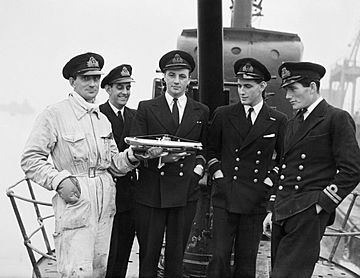
The body was supposed to be the victim of an aeroplane crash, and it was decided that to try to simulate the accident at sea using flares and other devices could be too risky and open to discovery. After seaplanes and surface ships were dismissed as being problematic, a submarine was chosen as the method of delivering the body to the region.
On 13 April 1943 the committee of the Chiefs of Staff met and agreed that they thought the plan should proceed. The committee informed Colonel John Bevan – the head of London Controlling Section, which controlled the planning and co-ordination of deception operations – that he needed to obtain final approval from Churchill. Two days later Bevan met the prime minister in his rooms at the Cabinet War offices and explained the plan. Churchill gave his approval to the operation, but delegated the final confirmation to Eisenhower, the overall military commander in the Mediterranean, whose plan to invade Sicily would be affected. Bevan sent an encrypted telegram to Eisenhower's headquarters in Algeria requesting final confirmation, which was received on 17 April.
Execution
In the early hours of 17 April 1943 the body of Michael was dressed as Martin. The pocket litter was placed on the body, and the briefcase attached. The canister with the body was placed in the 1937 Fordson van of an MI5 driver, St John "Jock" Horsfall, who had been a racing champion before the war. Cholmondeley and Montagu travelled in the back of the van, which drove through the night to Greenock, west Scotland, where the canister was taken on board the submarine HMS Seraph, which was preparing for a deployment to the Mediterranean. Seraph's commander, Lt. Bill Jewell, and crew had previous special operations experience.
On 19 April Seraph set sail and arrived just off the coast of Huelva on 29 April after having been bombed twice en route. After spending the day reconnoitring the coastline, on 30 April, they opened the container and lowered the body into the water.
Spanish handling of the body and the ramifications
The body of "Major Martin" was found at around 9:30 am on 30 April 1943 by a local fisherman; it was taken to Huelva by Spanish soldiers, where it was handed over to a naval judge. Haselden, as vice-consul, was officially informed by the Spaniards; he reported back to the Admiralty that the body and briefcase had been found. A series of pre-scripted diplomatic cables were sent between Haselden and his superiors, which continued for several days. The British knew that these were being intercepted and, although they were encrypted, the Germans had broken the code; the messages played out the story that it was imperative that Haselden retrieve the briefcase because it was important.
The body was released by the Spanish and, as Major Martin, was buried in the San Marco section of Nuestra Señora cemetery in Huelva, with full military honours on 2 May.
The Spanish navy retained the briefcase and, despite pressure from Adolf Clauss and some of his Abwehr agents, neither it nor its contents were handed over to the Germans. On 5 May the briefcase was passed to the naval headquarters at San Fernando near Cadiz, for forwarding to Madrid. While at San Fernando the contents were photographed by German sympathisers, but the letters were not opened. Once the briefcase arrived in Madrid, its contents became the focus of attention of Karl-Erich Kühlenthal, one of the most senior Abwehr agents in Spain. He asked Admiral Wilhelm Canaris, the head of the Abwehr, to personally intervene and persuade the Spanish to surrender the documents. Acceding to the request, the Spanish removed the still-damp paper by tightly winding it around a probe into a cylindrical shape, and then pulling it out between the envelope flap – which was still closed by a wax seal – and the envelope body. The letters were dried and photographed, then soaked in salt water for 24 hours before being re-inserted into their envelopes, without the eyelash that had been planted there. The information was passed to the Germans on 8 May. This was deemed so important by the Abwehr agents in Spain that Kühlenthal personally took the documents to Germany.
On 11 May the briefcase, complete with the documents, was returned to Haselden by the Spanish authorities; he forwarded it to London in the diplomatic bag. On receipt, the documents were forensically examined, and the absence of the eyelash noted. Further tests showed that the fibres in the paper had been damaged by folding more than once, which confirmed that the letters had been extracted and read. An additional test was made as the papers – still wet by the time they returned to London – were dried out: the folded paper dried into the rolled form it had when the Spaniards had extracted it from the envelope. To allay any potential German fears that their activities had been discovered, another pre-arranged encrypted but breakable cable was sent to Haselden stating that the envelopes had been examined and that they had not been opened; Haselden leaked the news to Spaniards known to be sympathetic to the Germans.
Final proof that the Germans had been passed the information from the letters came on 14 May when a German communication was decrypted by the Ultra source of signals intelligence produced by the Government Code and Cypher School (GC&CS) at Bletchley Park. The message, which had been sent two days previously, warned that the invasion was to be in the Balkans, with a feint to the Dodecanese. A message was sent by Brigadier Leslie Hollis – the secretary to the Chiefs of Staff Committee – to Churchill, then in the United States. It read "Mincemeat swallowed rod, line and sinker by the right people and from the best information they look like acting on it."
Montagu continued the deception to reinforce the existence of Major Martin, and included his details in the published list of British casualties which appeared in The Times on 4 June. By coincidence, also published that day were the names of two other officers who had died when their plane was lost at sea, and opposite the casualty listings was a report that the film star Leslie Howard had been shot down by the Luftwaffe and died in the Bay of Biscay; both stories gave credence to the Major Martin story.
German reaction
On 14 May 1943 Grand Admiral Karl Dönitz met Hitler to discuss Dönitz's recent visit to Italy, his meeting with the Italian leader Benito Mussolini and the progress of the war. The Admiral, referring to the Mincemeat documents as the "Anglo-Saxon order", recorded
The Führer does not agree with ... [Mussolini] that the most likely invasion point is Sicily. Furthermore, he believes that the discovered Anglo-Saxon order confirms the assumption that the planned attacks will be directed mainly against Sardinia and the Peloponnesus.
Hitler informed Mussolini that Greece, Sardinia and Corsica must be defended "at all costs", and that German troops would be best placed to do the job. He ordered that the experienced 1st Panzer Division be transferred from France to Salonika, Greece. The order was intercepted by GC&CS on 21 May. By the end of June, German troop strength on Sardinia had been doubled to 10,000, with fighter aircraft also based there as support. German torpedo boats were moved from Sicily to the Greek islands in preparation. Seven German divisions transferred to Greece, raising the number present to eight, and ten were posted to the Balkans, raising the number present to eighteen.
On 9 July the Allies invaded Sicily in Operation Husky. German signals intercepted by GC&CS showed that even four hours after the invasion of Sicily began, twenty-one aircraft left Sicily to reinforce Sardinia. For a considerable time after the initial invasion, Hitler was still convinced that an attack on the Balkans was imminent, and in late July he sent General Erwin Rommel to Salonika to prepare the defence of the region. By the time the German high command realised the mistake, it was too late to make a difference.
Aftermath
On 25 July 1943, as the battle for Sicily went against the Axis forces, the Italian Grand Council of Fascism voted to limit the power of Mussolini, and handed control of the Italian armed forces over to King Victor Emmanuel III. The following day Mussolini met the King, who dismissed him as prime minister; the former dictator was then imprisoned. A new Italian government took power and began secret negotiations with the Allies. Sicily fell on 17 August after a force of 65,000 Germans held off 400,000 American and British troops long enough to allow many of the Germans to evacuate to the Italian mainland.
The military historian Jon Latimer observes that the relative ease with which the Allies captured Sicily was not entirely because of Mincemeat, or the wider deception of Operation Barclay. Latimer identifies other factors, including Hitler's distrust of the Italians, and his unwillingness to risk German troops alongside Italian troops who may have been on the point of a general surrender. The military historian Michael Howard, while describing Mincemeat as "perhaps the most successful single deception operation of the entire war", considered Mincemeat and Barclay to have less impact on the course of the Sicily campaign than Hitler's "congenital obsession with the Balkans". Macintyre writes that the exact impact of Mincemeat is impossible to calculate. Although the British had expected 10,000 killed or wounded in the first week of fighting, only a seventh of that number became casualties; the navy expected 300 ships would be sunk in the action, but they lost 12. The predicted 90-day campaign was over in 38.
Smyth writes that as a result of Husky, Hitler suspended the Kursk offensive on 13 July. This was partly because of the performance of the Soviet army, but partly because he still assumed that the Allied landing on Sicily was a feint that preceded the invasion in the Balkans, and he wanted to have troops available for fast deployment to meet them. Smyth observes that once Hitler gave up the initiative to the Soviets, he never regained it.
Legacy
Montagu was appointed an Officer of the Order of the British Empire in 1944 for his part in Operation Mincemeat; for masterminding the plan, Cholmondeley was appointed a Member of the Order in 1948. Duff Cooper, a former cabinet minister who had been briefed on the operation in March 1943, published the spy novel Operation Heartbreak (1950), which contained the plot device of a body – with papers naming him as William Maryngton – being floated off the coast of Spain with false documents to deceive the Germans. The British security services decided that the best response was to publish the story of Mincemeat. Over the course of a weekend Montagu wrote The Man Who Never Was (1953), which sold two million copies and formed the basis for a 1956 film. The security services did not give Montagu complete freedom to reveal operational details, and he was careful not to mention the role played by signals intelligence to confirm that the operation had been successful. He was also careful to obscure "the idea of an organised programme of strategic deception ... with Mincemeat being presented as a 'wild' one-off caper". In 1977 Montagu published Beyond Top Secret U, his wartime autobiography which gave further details of Mincemeat, among other operations. In 2010 the journalist Ben Macintyre published Operation Mincemeat, a history of the events.
A 1956 episode of The Goon Show, titled "The Man Who Never Was", was set during the Second World War, and referred to a microfilm washed up on a beach inside a German boot. The play Operation Mincemeat, written by Adrian Jackson and Farhana Sheikh, was first staged by the Cardboard Citizens theatre company in 2001. The work focused on Michael's homelessness. In his book The Double Agents, the writer W. E. B. Griffin depicts Operation Mincemeat as an American operation run by the Office of Strategic Services. Fictional characters are blended with Ian Fleming and the actors David Niven and Peter Ustinov.
The story was the basis for the 2014 musical Dead in the Water, performed at the Camden, Brighton and Guildford Fringe Festivals in 2014. In 2015 the Welsh theatre company Theatr na nÓg produced Y dyn na fu erioed (The Man Who Never Was), a musical based on the operation and Glyndwr Michael's upbringing in Aberbargoed. The musical was performed by primary school children from Caerphilly County Borough during that year's Eisteddfod yr Urdd. Another musical, Operation Mincemeat, is based on the operation; it was initially staged in 2019 at the New Diorama Theatre, London, then moved to the Fortune Theatre in 2023. In 2014 a BBC television miniseries, Fleming: The Man Who Would Be Bond, dramatised some aspects of Operation Mincemeat, and Fleming's connection to the operation. In 2022 the film Operation Mincemeat was released, with Colin Firth as Montagu and Matthew Macfadyen as Cholmondeley.
The Commonwealth War Graves Commission took responsibility for Major Martin's grave in Huelva in 1977. In 1997 the Commission added the postscript "Glyndwr Michael served as Major William Martin RM". In November 2021 the Jewish American Society for Historic Preservation, working with the Association of Jewish Ex-Servicemen and Women and the London Borough of Hackney, placed a memorial at the Hackney Mortuary.
See also
 In Spanish: Operación Mincemeat para niños
In Spanish: Operación Mincemeat para niños
- Operation Copperhead
- Operation Bodyguard


